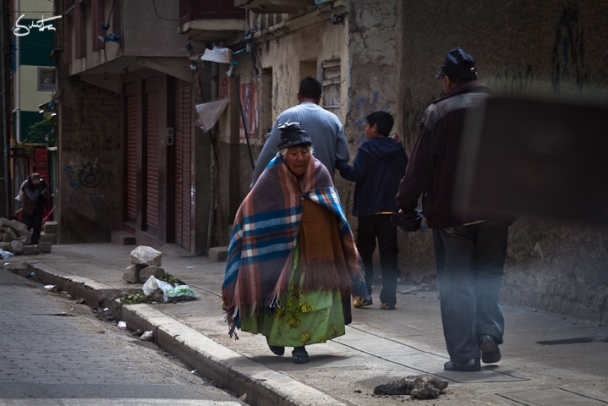Slyszalam niejednokrotnie, mieszkajac w Cochabambie, ze Indianie Aymara sa zimni i nieprzyjazni (w odroznieniu od Keczua), ale po wizycie w La Paz zupelnie sie z tym przekonaniem nie zgadzam. Na swojej drodze spotkalismy mnostwo rdzennych mieszkancow Polnocy, ktorzy wydali sie nam bardzo przystepni. Ciekawostka jest to, ze znaczna czesc mieszkancow La Paz pochodzi z innych czesci Boliwii i naprawde trudno jest rozroznic mezczyzne z ludu ‘Aymara‘ od ‘Keczua‘. Z kobietami jest latwiej, kiedy nosza one swoje tradycyjne stroje, ktore w wypadku mieszkanek La Paz stanowia dlugie grube pollery, chusty i slynne czarne meloniki.

Inna sprawa sa natomiast bezdomni na ulicach stolicy, ktorych ogromna liczba przyczynia sie do poczucia ogolngo pesymizmu, unoszacego sie nad tym wielkim miastem. Pochodza oni czesto z okolic Potosi, co mozna stwierdzic po typowych dla tych regionow ubran. Poza tym, w samym La Paz im wyzej tym zimniej, a zycie staje sie biedniejsze i ciezsze, co moglismy stwierdzic podczas naszej wyprawy po ‘miradorach’. Tutaj sprawdza sie wiec powiedzenie ‘biednemu zawsze pod gorke’ (i wiatr w oczy)…

Jednak mimo calego tego zimna, wysokosci, trudnosci w oddychaniu – zycie kreci sie tutaj dalej, a ludzie, choc ubodzy (wedlug naszych Europejskich standardow), znajduja czas na smiech, przyjazne slowo czy zabawe z dziecmi, co moglismy obserwowac w Sobote Wielkanocna na Plaza Mayor, przy kosciele Sw. Franciszka, czy w jednym z podmiejskich parkow. Niezwykle kolorowy spektakl ludzkiej roznorodnosci!

Na uwage zasluguje niezwykla pracowitosc rodowitych Boliwijczykow, ktorzy by zarobic na kawalek chleba paraja sie wieloma mniejszymi pracami – od sprzedawcy galaretek do pucybuta. Powinnismy wziac z nich przyklad – ‘zadna praca przeciez nie hanbi’ (choc nie kazda przynosi satysfakcje).

Ci, ktorzy o tym zapomnieli, zwykle staczaja sie na margines spoleczny, uciekajac przed rzeczywistoscia w alkoholizm i narkotyki – tak zwani ‘cleferos‘ (‘clefa‘- klej).
***
I heard many times, while living in Cochabamba, that the Aymara people are cold and unfriendly, but after a visit to La Paz I must totally disagree with that conviction. On our way we met a lot of indigenous people of the North, who were kind and very approachable. Interestingly, the large part of the inhabitants of La Paz came from other parts of Bolivia and it’s really difficult to distinguish between a man of ‘Aymara’ origin and ‘Quechua’. With women is easier if they wear their traditional polleras – in La Paz they wear long tick skirts, scarfs and black bowler hats.

There are unfortunately many homeless people on the streets of the capital city that often come from Potosi district – you can say that looking at typical clothes they wear (the most beautiful and elaborate in the same time!). Besides, the city has it’s own hierarchy – the higher the colder and life becomes poorer and heavier, as we could see during our trips. In here the popular Polish saying: ‘Poor have always up the hill and wind into eyes’ really makes sense …

However, despite all this cold, high altitude, difficulty in breathing – life goes on and people, although poor (according to our European standards), finds time to laugh, to say a friendly word or have fun with the kids, which we could observe during an Easter Saturday at the Plaza Mayor, the square of St. Francis church and in one of the suburban parks. Amazing spectacle of human diversity!

It is worthy to mention an extraordinary diligence of native Bolivians who ‘earn their bread’ by doing many small and smaller jobs – from selling jellos and ice-creams to shoe shining. We should take them as and example – ‘no job is too humble‘ (although not every brings satisfaction).

Those who forgot about this virtue, usually start drinking and taking drugs. Here they are called ‘cleferos‘ from ‘clefa” that means glue.

















































moda zaiste charakterystyczna. A zdjęcia znów piękne!
Stunning collection of photos! They are so thought-provoking, telling many stories. Great job!
ah, dziekuje! (z pol-rocznym opoznieniem:)